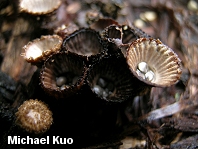Mmmm....Woodalicious
Cyathus striatus is heterotrophic meaning it has to obtain its nourishment from organic material and can not create its own food. Thus, this fungus decomposes the decaying material of wood debris or wood mulch. Also, Cyathus striatus uses extracellular digestion to transport its food internally. Extracellular digestion takes place outside the organism. Special enzymes break down lignin and cellulose in the wood. The lignin and cellulose are broken down into simpler compounds which are absorbed by hyphae. Furthermore, Cyathus striatus stores its food as glycogen, which is similar to animals. Lastly, this fungus grows on a substrate and does not have a circulatory system (Volk, March 12, 2007).
Cyathus striatus has adapted to its environment and habitat in several ways. First, the shape of the “nests” or cups of the fruiting bodies provide more ability for the fungi to easily spread its spores. Also, the dark color and the size of the fungi adds protection when they are not organized in large clusters. Unfortunately, the large clusters allow the fungi to be seen by predators (Kuo, March 12, 2007).
Furthermore, the structures of Cyathus striatus relate well to their functions. As mentioned before, the cup shaped fruiting bodies contain basidiospores. The fruiting bodies relate well to their function because they “house” the basidiospores until they are mature and ready to be dispersed.
This fungus as an organism itself does not move. However, the basidiospores within the fruiting body are dispersed via raindrops hitting |
For information on the life history and reproduction of Cyathus striatus click here.
